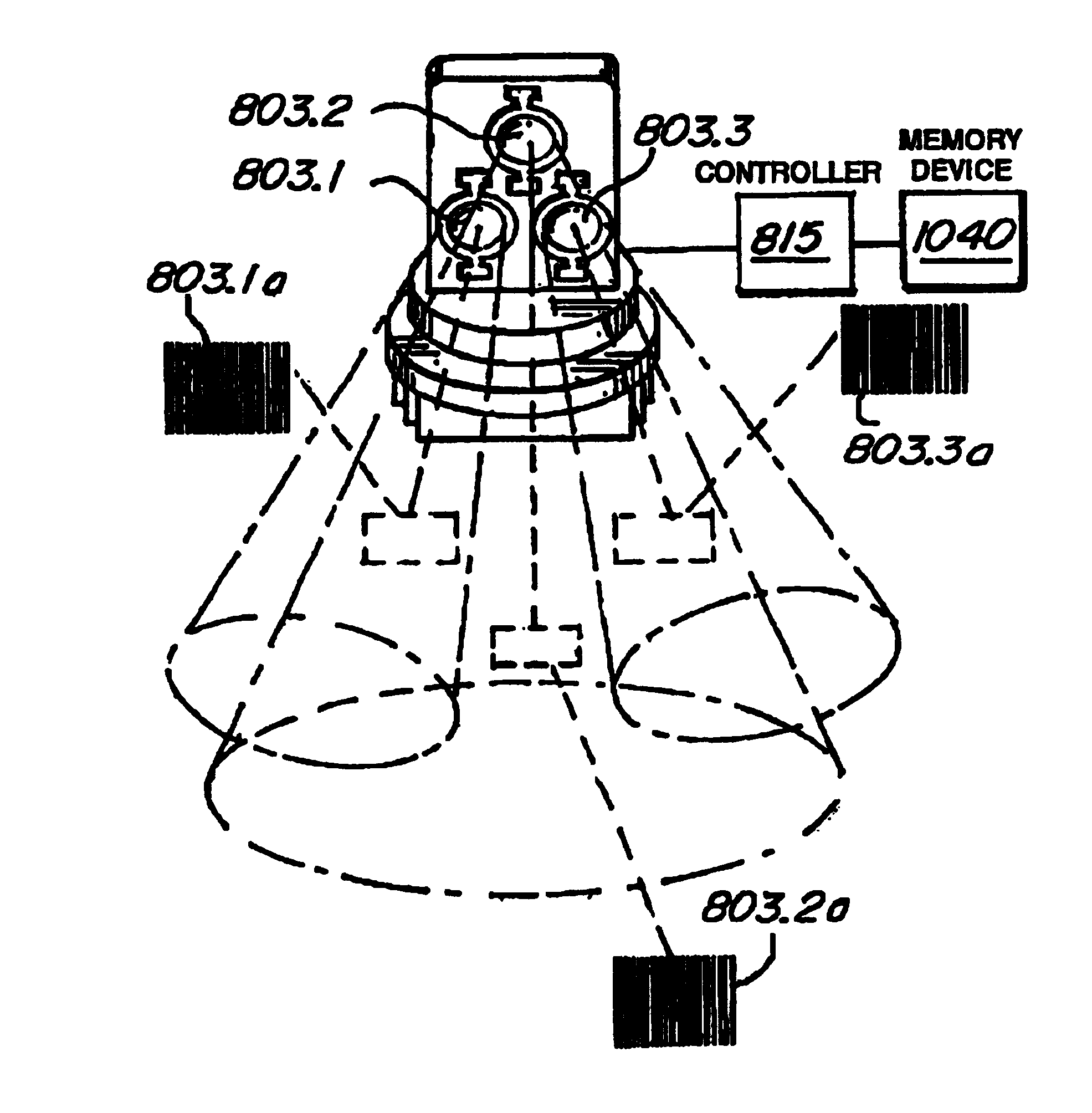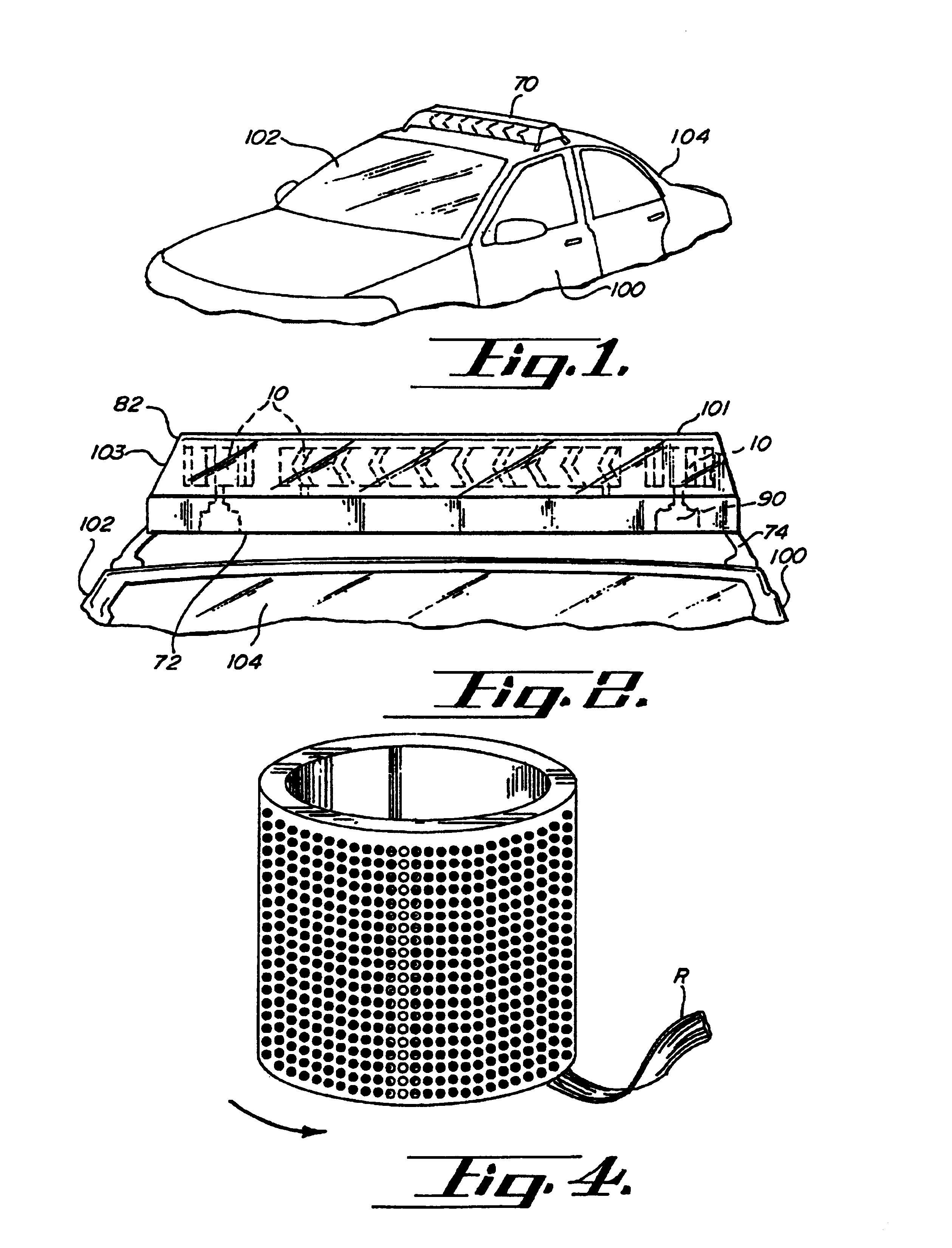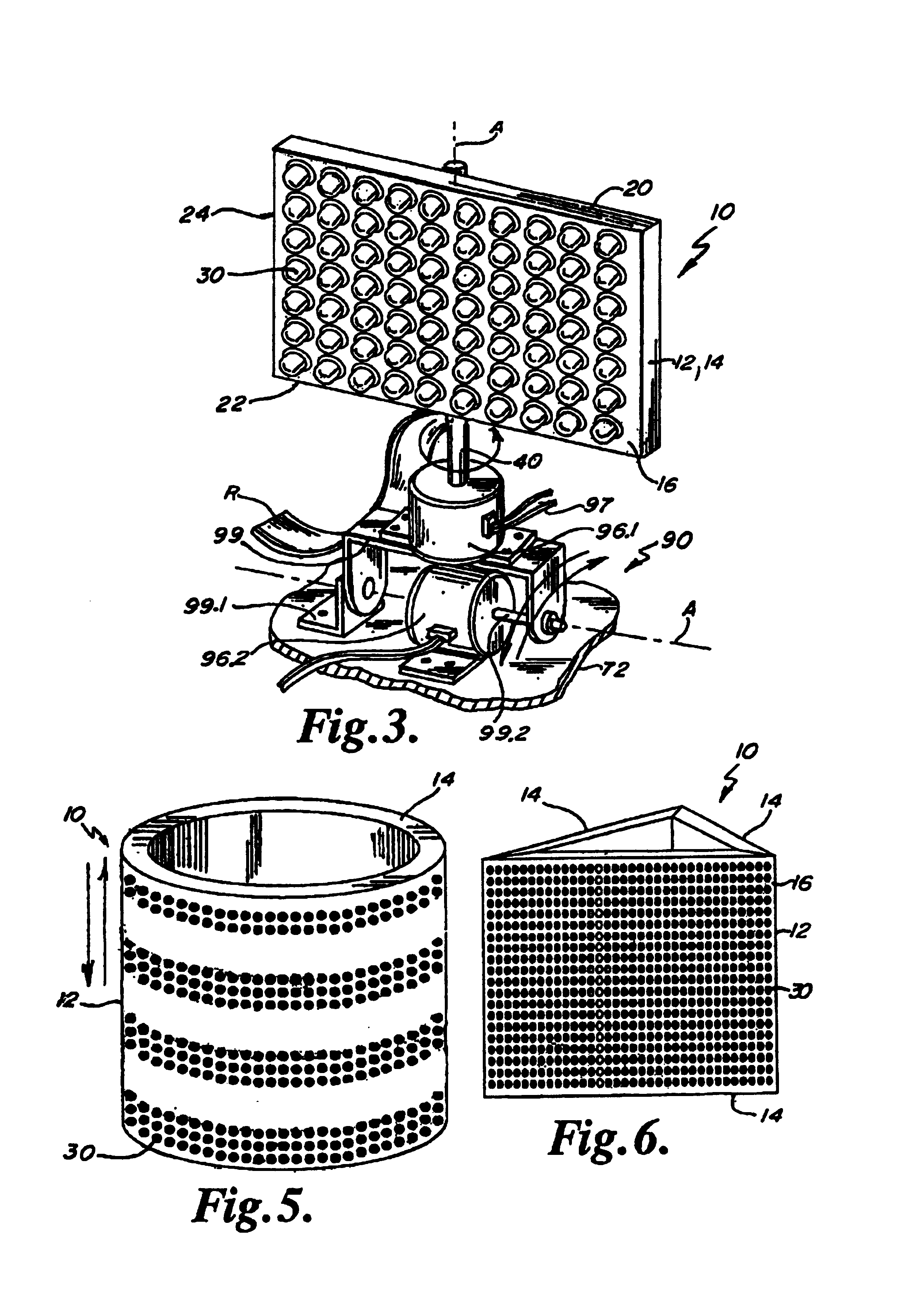Many problems exist with the known methods for producing warning light signals.
One particular problem with known light sources is their reliance on
mechanical components to revolve or oscillate the lamps to produce the desired light signal.
Additionally, these components increase the size of the light bar or emergency lights which may adversely affect the vehicle's aerodynamic characteristics.
Moreover, because of the relatively poor reliability of conventional lighting and the complexity of the present strobe rotational systems there is an increased likelihood that a breakdown of the light bar or
light source will occur requiring the repair or replacement of the
defective component.
Finally, conventional light bars and light sources require a relatively large amount of
electrical current during operation.
The demands upon the electrical power
system for a vehicle may therefore exceed available electrical resources reducing optimization of performance or worse, generating a potential
hazard from shorted or over-heated systems.
Halogen lamps or gaseous
discharge xenon lamps generally emanate large amounts of heat which is difficult to dissipate from a sealed light
enclosure or
emergency light and which may damage the electronic circuitry contained therein.
In addition, these lamps consume large amounts of current requiring a large power supply, battery, or electrical source which may be especially problematic for use with a vehicle.
These lamps also generate substantial electromagnetic emissions which may interfere with
radio communications for a vehicle.
Finally, these lamps, which are not rugged, have relatively
short life cycles necessitating frequent replacement.
Another problem with the known warning signal lights is the use of filters to produce a desired color.
Furthermore, filters fade or flake over time rendering the filters unable to consistently produce a desired color for observation in an emergency situation.
These problems associated with traditional signaling lamps are exacerbated by the fact that creating multiple light signals requires multiple signaling lamps.
Further, there is little flexibility in modifying the light signal created by a lamp.
For example, changing a stationary lamp into one that rotates or oscillates would require a substantial modification to the light bar or
light source which may not be physically or economically possible.
The color blue is particularly hard to produce in this manner.
Corrosive effects may destroy the trigger wire and the wire contacts leading to the
anode and
cathode.
Corrosion is enhanced because of the
high heat generating characteristics of the lamp which may heat the air inside the lamp fixture when the lamp is in use, and this heated air may condense when the lamp is off resulting in
moisture buildup inside the fixture.
The buildup of
moisture may result in the shorting out of the electrical wires and degrade the performance of the emission wire, sometimes preventing proper
ionization of the gas within the
xenon gas discharge lamp.
Another problem with the known warning signal lights is the use of rotational and / or oscillating mechanisms which are utilized to impart a rotational or oscillating movement to a
light source for observation during
emergency situations.
These
mechanical devices are frequently cumbersome and difficult to incorporate and couple onto various locations about a vehicle due to the size of the device.
These
mechanical devices also frequently require a relatively large power source to impart rotational and / or oscillating movement for a light source.
Another problem with the known warning signal lights is the absence of flexibility for the provision of
variable intensity for the light sources to increase the number of available distinct and independent visual
light effects.
No known warning light systems utilize a variable or modulated
light intensity to modify a standard lighting effect nor do they have the design flexibility to easily make those changes.
It has also not been known to provide alternative
colored LED light sources which may be electrically controlled for the provision of any desired pattern of light signal such as flashing, pulsating, oscillating, modulating, variable, rotational, alternating, strobe, sequential, and / or combination
light effects.
Other problems associated with the known warning signal lights relate to the restricted positioning of the
signal light on a vehicle due to the size and shape of the light source.
Light bars or light sources generally extended perpendicular to the longitudinal axis of a vehicle and were therefore more difficult to observe from the sides by an individual.
Observation from the sides, or at an
acute angle relative to the sides, frequently resulted in reduced observation of emergency lights during an emergency situation.
In the past, illumination of an area to the front or to the sides of an
emergency vehicle during low light conditions has been problematic.
A problem has also existed with respect to the use of emergency lights on unmarked law
enforcement vehicles.
The known dome devices are also clumsy, have large current draw requirements, and are difficult to store in a convenient location for retrieval in an emergency situation by an individual.
One draw back associated with the use of
radio frequency communication is the limited number of radio frequencies available for use within
high density traffic areas where radio saturation may cause an
unsafe condition through delayed communication and response during transmission of routine information.
In addition, a number of available radio frequencies have been assigned for digital transmission further limiting the accessability and / or availability of transmission of routine information.
Further, radio frequencies have generally not been available for certain applications including communication between motor vehicles and ground sources related to
avionics such as approach lighting and / or taxi location identification.
Another problem associated the use of radio frequencies for communication of routine information is the material intensive nature of the transmitters and / or receivers.
The
radio frequency transmitters and receivers are generally expensive and further require a large power supply which is a concern for motor vehicle and / or aircraft applications.
In general,
cell phones and / or
microwave communication are not viable communication alternatives and / or options due to the need for instantaneous communication and
receipt of information without the necessity to identify, dial, connect, and couple to a
receiver.
Further,
laser optic communication may be difficult to achieve due to the inflexibility of the lasers for transmission of both a directional and / or non-directional signal.
The rotating features of a dome light and / or flashing
beacon include many of the same problems as earlier described related to size, durability, performance, current draw parameters, and ease of maintenance.
In general, the light sources utilized within a rotating dome light or flashing
beacon are not durable or efficient.
Due to human factors, in the past it has generally been quite difficult to instantaneously identify the
exact location of aircraft adjacent to runways during taxiing.
Therefore, the brightness, durability, and economics related to current draw have not been maximized to provide optimal performance for the known stationary lights,
runway lights, and / or approach lights for an airport.
Further, in the past an aircraft rotating exterior dome illumination source has not been used to simultaneously function as a
communication device for the transmission and
receipt of variable and / or pulsated light signals as generated from an LED light source.
Further, it has not been know to use a variable and / or pulsating light signal or SIT-TEL communication, as generated from an anti-collision light, as an information courier through the use of LED technology.
No economical and / or low power
backup system to the VFR location indicators is generally available.
The high power requirements and equipment expense of VFR
radar systems, and the necessity for redundant
backup systems, is quite costly for an airport.
Radio frequency communications are frequently limited, in that there are a finite number of available radio frequencies for commercial and / or private use.
In a number of instances, the use of
radio frequency transmissions may cause interference with a localized environment which in turn may adversely affect adjacent radio frequency transmitters.
No device has been previously known which utilize LED technology to generate light signals used as a carrier of information for the replacement of radio transmissions, and as particularly used in association with vehicles and / or aircraft.
In addition, no device is known which utilizes a light signal for transmission to a
receiver which may then trigger audio and / or pre-stored information or convert information transmitted through the use of pulsed light into an
audio signal.
A further problem with aircraft rotating illumination domes and / or flashing beacons is the failure of the illumination domes and / or flashing beacons to continue operations during emergency landing situations where the power for the aircraft is terminated.
Due to the large power requirements for the rotating domes and / or flashing beacons, any power outage within the aircraft normally terminates the illumination of the rotating dome and / or flashing
beacon.
The power requirements for the rotating domes and / or flashing beacon illumination sources is generally sufficiently large to prohibit the transportation and use of additional battery sources for an aircraft during emergency landing situations.
The optical and / or focused optic devices are generally expensive and may be extremely difficult to operate during moving conditions.
Vehicles having the targeted
license plates frequently change lanes and / or bounce upon uneven roadways rendering observation difficult.
No device is presently known which is inexpensive and which utilizes LED technology in association with a
license plate, which includes the use of an LED
transmitter and light
receiver as coupled to a controller, to receive and transmit a pulsed LED light signal or SIT-TEL communication as a carrier of information to a law
enforcement vehicle.
No device is also known which minimizes environmental interference and accurately confirms the correct tagging, observation, and / or interrogation of a license plate by a law enforcement officer.
Further, no
backup device is known which supplements the confirmation
system for
verification of identification of a vehicle subject to consideration.
Another problem with the known law enforcement identification systems for vehicles is that law enforcement personnel are frequently required to place themselves within a certain proximity of a vehicle under observation.
Proximity to a suspect vehicle significantly increases the likelihood of recognition of the location of the law enforcement personnel.
No
communication device is currently known which provides flexibility to select between a focused interrogation
specific function versus a non-directional interrogation function for investigation of vehicles relative to a law enforcement officer through the use of LED technology.
Further, no communication device is known which may simultaneously check and compare all license plates within the proximity of a law enforcement vehicle for a specific status such as a stolen
vehicle identification through a continuous non-directional sweep of a transmitted LED light signal.
These warning
buoy light sources have suffered a relatively
short life and have required a relatively large battery source.
As such, the warning light signals used with marine buoys have not been efficient for signaling marine traffic.
In addition, no marine
buoy is known which incorporates an LED light source which contains a modulated and / or variable light controller which may simultaneously transmit a pulsed light signal or SIT-TEL communication to transmit information obviating the necessity for radio transmissions.
Currently each year a significant number of automobiles and other motor vehicles are involved in accidents with trains at railroad crossings.
Frequently these accidents occur at railroad crossings in rural areas which are not marked with railroad crossing gates, warning bells, and / or flashing light signals.
The absence of warning devices is frequently the result of economic considerations at remote and / or low traffic areas.
A problem with the radio frequency transmissions is the lack of available radio wavelengths, and the localized radio frequency interference, adjacent to intersections.
In addition, the devices as known frequently have a large
current consumption and are relatively expensive.
The positioning and wiring of OPTICOM receiving and switching devices upon semaphores is generally elevated above an intersection, increasing initial construction expenses.
The positioning of the OPTICOM receiving and switching devices, therefore renders maintenance and / or replacement problematic.
In addition, it has not been known to improve the useful life of an OPTICOM device through the use of long life rugged LED technology which may be operated by a
low voltage power source such as a battery and / or
solar power unit.
No device is known which provides simultaneous communication to a plurality of independently operated units of soldiers within a theater of operation which coordinates movement, actions, location of friendly troops, and / or identifies the location of hostile soldiers through the use of a pulsed light communication system.
In this regard, no device is known which may have the dual functionality of a light source such as a
flare in combination with a pulsed SIT-TEL communication system.
In addition,
silence and the
secretion of the location of troops within a theater of operations is frequently critical.
Within situations necessitating
silence, the use of radio transmissions is prohibited leaving soldiers without effective communications.
 Login to View More
Login to View More  Login to View More
Login to View More 


